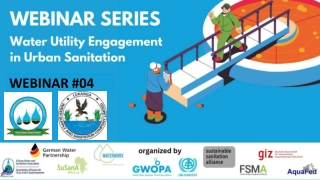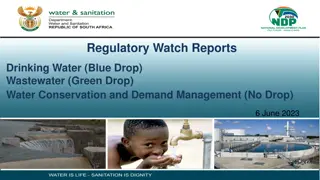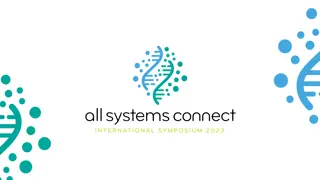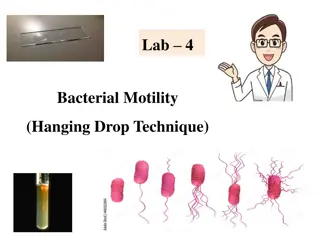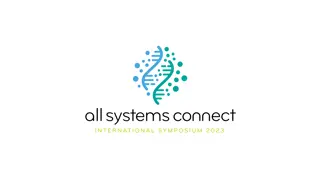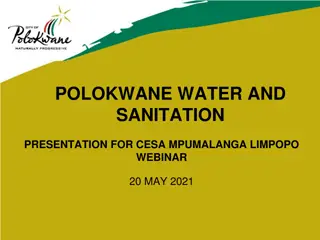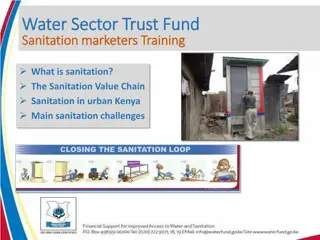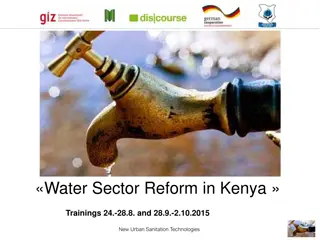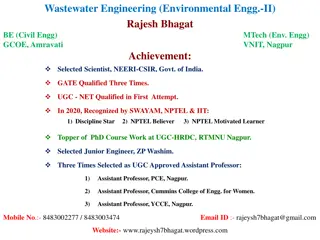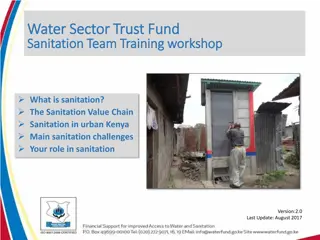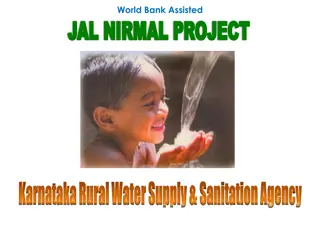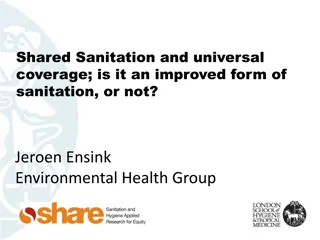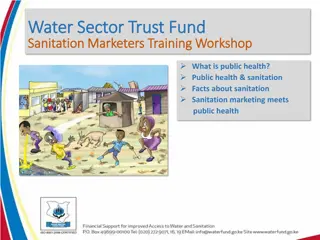Blue and Green Drop Reports Presentation to Portfolio Committee on Water and Sanitation
Blue and Green Drop certification programs were initiated to improve water and wastewater management by amalgamating legal requirements and best practices. The programs focus on risk management and seek to identify critical areas for sustainable improvement. BDRR and GDRR ratings serve as tools for authorities to make strategic decisions and enhance service delivery, ensuring compliance with water quality standards.
Download Presentation

Please find below an Image/Link to download the presentation.
The content on the website is provided AS IS for your information and personal use only. It may not be sold, licensed, or shared on other websites without obtaining consent from the author.If you encounter any issues during the download, it is possible that the publisher has removed the file from their server.
You are allowed to download the files provided on this website for personal or commercial use, subject to the condition that they are used lawfully. All files are the property of their respective owners.
The content on the website is provided AS IS for your information and personal use only. It may not be sold, licensed, or shared on other websites without obtaining consent from the author.
E N D
Presentation Transcript
Briefing to the Portfolio Committee on Water and Sanitation on the PRESENTATION TITLE Blue and Green Drop Reports Presented by: Name Surname Directorate Date Presented by: Mr A. Singh Deputy Director-General: Water Resources Services and Sanitation Reform 24 October 2018
CONTENTS Background Criteria for assessments Process to release reports What has been done since 2014 Trends analysis for BDRR 2012-2016 Challenges Recommendations 2
Background Blue and Green Drop Certification Programmes Incentive-risk based initiated in 2008 as a means to identify and improve performance of WSAs in water and wastewater management; Seek to amalgamate legal requirements and best practices within the domain of drinking water quality management and wastewater services towards sustainable improvement; Also focus on implementation of risk management through identification of critical and high risk areas including implementation measures(Blue Drop Risk Rating {BDRR} and Green Drop Risk Rating {GDRR}). regulatory programmes of corrective 3
Background (cont) Blue Drop Risk Rating (BDRR) BDRR serves as a precautionary tool for water services authorities to implement strategic and operational decisions to improve service delivery or mitigate identified risks. The BDRR focuses on water safety planning, technical skills and drinking water quality compliance It should not be confused with the Blue Drop status, but the latter may not be achieved without meeting the requirements of the BDRR 4
Background (cont) Green Drop Risk Rating (GDRR) GDRR serves as a precautionary tool for water services authorities to implement strategic and operational decisions to improve service delivery or mitigate identified risks. The GDRR focuses on wastewater risk abatement planning, design capacity vs operational flow, technical skills and effluent compliance It should not be confused with the Green Drop status, but the latter may not be achieved without meeting the requirements of the GDRR 5
Criteria for assessments GD Full assessment criteria GD Partial assessment criteria Criteria Description Criteria Description 1. Wastewater Risk Abatement Planning 1. Wastewater Risk Abatement Planning 2. Technical Skills 2. Technical Skills 3. Operation, Maintenance, Monitoring 3. Operation, Maintenance, Monitoring 4. Effluent Compliance 5. Solids/Sludge Handling 4. Effluent Compliance 6. Management Accountability & Local Regulation 5. Design capacity vs Operational capacity 7. Asset Management 6
Criteria for assessments (cont) BD Full assessment criteria BD partial assessment criteria Criteria Description Criteria Description 1. Water Safety Planning 1. Risk Management (Water safety Planning & implementation and full SANS 241) 2. Process Management & control 3. Drinking water quality verification 2. Technical Skills 3. Drinking water quality compliance 4. Management accountability & local regulation 5. Asset Management 7
Process to release Report Confirmation assessments with WSAs WSA Assessments Compile WSA/provincial/ national reports Moderation of scorecards Conduct quality assurance Submit for approval 8
What has been done since 2014 The 2015 Blue Drop Progress Assessment Report focusing on risk based management (Blue Drop Risk Rating) was finalized and submitted for approval Monitoring of non-compliant systems enhanced through inclusion in the Annual Performance Plan (PPI 1.12 and 1.1.4 from 2016/17 and now combined in 2018/19 to PPI 1.1.2) The 2016 Blue Drop Progress Assessment has been completed and the draft Report is undergoing quality assurance Integration of the Blue and Green Drop Systems to Integrated Regulatory Information System (migration to IRIS in October 2017 and October 2018 respectively) 2016/17 Green Drop Progress (Partial) Assessments initiated in 2017 and still in progress 2017 Blue Drop Progress (partial) assessments commenced in beginning 2018 and still in progress 9
TREND ANALYSIS FOR BDRR 2012-2016 The percentage of systems in low risk category have steadily increased from 2012 to 2014 followed by slight decrease in 2016. The opposite is noted for high and critical risk categories which have decreased from 2012 to 2014 and then increased in 2015 Percentage of high risk categories have decreased between 2015 and 2016 while critical risk categories have continued to increase in 2016 which now account for 11.6% of all systems The observed increase in systems under critical risk is due to: Lack of sufficient data and insufficient monitoring Aging infrastructure including vandalism and lack of operations and maintenance (O&M) Lack of implementation of risk management plans (water safety plans) Trend Analysis of National BDRR : 2012 to 2016 Critical High Medium Low 26 1000 93 111 249 155 900 234 Number of systems 259 800 217 238 700 396 600 288 287 500 580 294 400 300 365 369 200 336 322 179 100 16 0 2012 2013 2014 2015 2016 10
CHALLENGES Limited technical expertise available within DWS 11
Recommendations Water Services Institutions Monitoring & data uploading to be prioritised and aligned to SANS 241 and water use authorisations Implement water safety planning Infrastructure asset management Enhancement of funding to : Source relevant technical skills O& M, and related financial investment aligned to technology in use & infrastructure DWS Source relevant technical skills Enhance funding to procure specialist skills 12
Thank you 13



